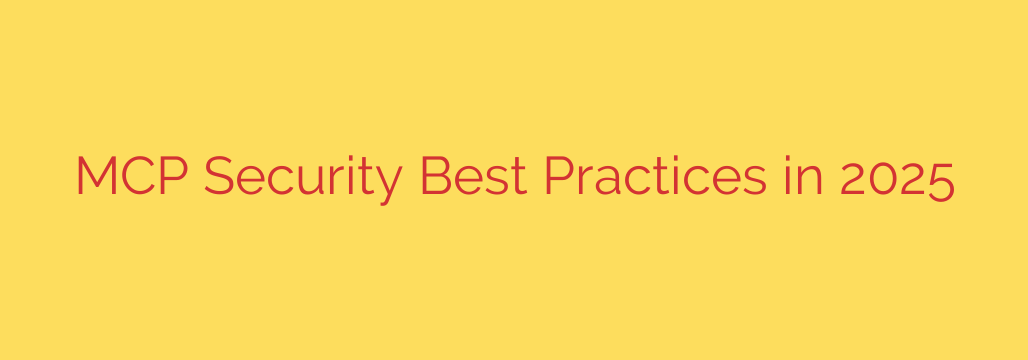
Fortifying Your Digital Core: Top MCP Security Best Practices for 2025
In today’s hyper-connected landscape, the security of your mission-critical platforms (MCPs) is not just an IT concern—it’s a fundamental business imperative. As threat actors deploy more sophisticated, AI-driven attacks, the old “set-it-and-forget-it” security models are no longer viable. Protecting the nerve center of your operations requires a forward-thinking, dynamic, and resilient strategy.
As we look toward 2025, a proactive and layered security posture is essential. Here are the definitive best practices to ensure your MCPs remain secure, stable, and prepared for the challenges ahead.
1. Embrace a Zero Trust Architecture (ZTA)
The days of the trusted internal network are over. A Zero Trust model operates on a simple but powerful principle: never trust, always verify. Every access request, whether from inside or outside the network, must be authenticated, authorized, and continuously validated before access is granted.
For your MCP, this means:
- Micro-segmentation: Isolate critical workloads from the rest of the network. A breach in one area should not be able to spread to your core systems.
- Strong Identity Verification: Enforce multi-factor authentication (MFA) for all users, especially those with privileged access.
- Assume Breach Mentality: The core principle of Zero Trust is to build your defenses assuming an attacker is already inside. This shifts the focus from perimeter defense to protecting individual resources.
2. Implement Granular and Dynamic Access Control
Controlling who can access your MCP and what they can do is paramount. Move beyond broad, static permissions and adopt a more intelligent approach to access management.
Key practices include:
- Principle of Least Privilege (PoLP): Every user, application, and service should only have the absolute minimum permissions necessary to perform its function.
- Just-in-Time (JIT) Access: Instead of granting permanent administrative rights, provide elevated permissions on-demand for a limited time. This dramatically reduces the attack surface.
- Role-Based Access Control (RBAC): Define clear roles with specific permissions and review them regularly. Ensure that as employees change roles or leave the company, their access rights are updated or revoked immediately.
3. Prioritize Proactive Vulnerability and Patch Management
Waiting for a monthly scan report is a reactive stance that leaves you vulnerable. In 2025, security must be proactive and intelligence-driven.
Actionable steps:
- Continuous Scanning: Implement automated tools that continuously scan your MCP infrastructure for new vulnerabilities.
- Risk-Based Prioritization: Not all vulnerabilities are created equal. Use threat intelligence to prioritize patching based on which vulnerabilities are actively being exploited in the wild, not just on their CVSS score.
- Establish a Rapid Patching Cadence: A known, unpatched vulnerability is a direct invitation for an attack. Have a clear and tested process for deploying critical security patches to your MCP without disrupting operations.
4. Harden Your Data with End-to-End Encryption
Data is the ultimate target for attackers. Protecting it requires robust encryption, both when it is stored and when it is moving across networks.
- Encryption in Transit: Use the latest cryptographic protocols, such as TLS 1.3, to secure all data flowing to and from your MCP.
- Encryption at Rest: Ensure all data stored within your databases, file systems, and backups is encrypted using strong algorithms like AES-256.
- Secure Key Management: Encryption is only as strong as your key management practices. Use a dedicated Hardware Security Module (HSM) or a secure key management service to protect your cryptographic keys from theft or misuse.
5. Leverage AI for Continuous Monitoring and Threat Detection
Human analysts cannot possibly monitor the sheer volume of log data generated by modern systems. This is where artificial intelligence and machine learning become critical security allies.
- Implement a Modern SIEM/SOAR Platform: A Security Information and Event Management (SIEM) tool aggregates log data, while a Security Orchestration, Automation, and Response (SOAR) platform automates responses to common threats.
- Anomaly Detection: Leverage machine learning to establish a baseline of normal activity on your MCP. The system can then instantly flag suspicious deviations, such as a user accessing a system at an unusual time or data being exfiltrated at an abnormal rate. This allows you to detect threats that traditional signature-based tools would miss.
6. Develop and Test a Resilient Incident Response (IR) Plan
No defense is impenetrable. When a security incident occurs, a well-rehearsed plan is the difference between a minor issue and a catastrophic business failure.
Your IR plan must be a living document that includes:
- Clear Roles and Responsibilities: Everyone on the response team must know exactly what their job is.
- Containment and Eradication Playbooks: Have pre-defined steps for isolating affected systems, removing the threat, and restoring operations safely.
- Regular Drills and Tabletop Exercises: Your incident response plan should be tested and refined regularly through realistic simulations. This builds muscle memory and reveals gaps in your strategy before a real crisis hits.
A Continuous Journey, Not a Destination
Securing your mission-critical platforms in 2025 is not a one-time project but a continuous cycle of assessment, hardening, and adaptation. By building your strategy on a foundation of Zero Trust and leveraging modern tools for proactive defense and rapid response, you can fortify your digital core and ensure it remains a secure and reliable engine for your business.
Source: https://collabnix.com/mcp-security-best-practices-2025/








